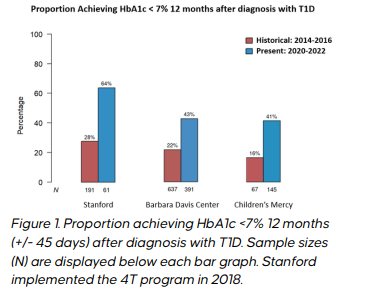Abstract: Improved Outcomes Among Children with New-Onset Type 1 Diabetes via the 4T Program
GT. Alonso1, F. Bishop2, B. Frohnert1, B. Lockee3, D. Maahs2, R. McDonough3, K. Panfil3, P. Prahalad2, L. Pyle1, V. Ritter2, L. Waterman1, M. Clements3
1University of Colorado Anschutz Medical Campus, Barbara Davis Center, Aurora, United States, 2Stanford University, Pediatrics, Palo Alto, United States, 3Children’s Mercy Kansas City, Kansas City, United States
Introduction: Most US children with type 1 diabetes (T1D) do not meet glycemic targets.
Objectives: We evaluated data from three clinics with robust quality improvement programs who participate in T1DX Quality Improvement Collaborative. One clinic had a systematic program (4T: Teamwork, Targets, Technology, Tight Control) focused on improving CGM access, communication of aggressive targets for glycemic control, weekly identification of patients at risk based on CGM metrics, and remote communication with at-risk individuals.
Methods: We included all patients with available data, aged 6 months to 21 years newly diagnosed with T1D between 1 June 2014 and 28 December 2016 (Historical) and 13 June 2020 and 5 March 2022 (Present). We determined the proportion of patients who achieved HbA1c < 7% at 12 months (±45 days) in the historical and present cohorts in each clinic.
Results: At diagnosis of T1D, for Stanford (1), the Barbara Davis Center (2), and Children’s Mercy (3), respectively, mean age was 10.2 (IQR 6.6-12.8), 10.1 (6.7- 13.1), and 12.1 (8.4-15.5) years; male sex was 52, 56, and 55%; HbA1c was 11.3 (SD 2.5), 12.9 (2.5), and 11.3% (2.9); and 29.8, 31.4, and 26.3% had public insurance. At 12 months technology use increased from 37.5 to 100% (CGM) and 32.7 to 49.6% (pump) (1); 35.5 to 81.1% and 36 to 45.6% (2); 18.6 to 83.4% and 41.7 to 48% (3). The proportions of patients achieving HbA1c < 7% at 12 months are shown by clinic and time period in Figure:

Conclusions: The proportion of patients achieving HbA1c < 7% improved at all clinics. Incomplete HbA1c data limit conclusions. The 4T program appears to augment other improvement efforts and requires multi-center study for translatability. Whether improved glycemic control in the first 12 months post-diagnosis translates to sustained benefits requires longitudinal study.
Link: https://www.react-profile.org/upload/KIT/system/uploads/ISPAD2023_Abstracts.pdf
